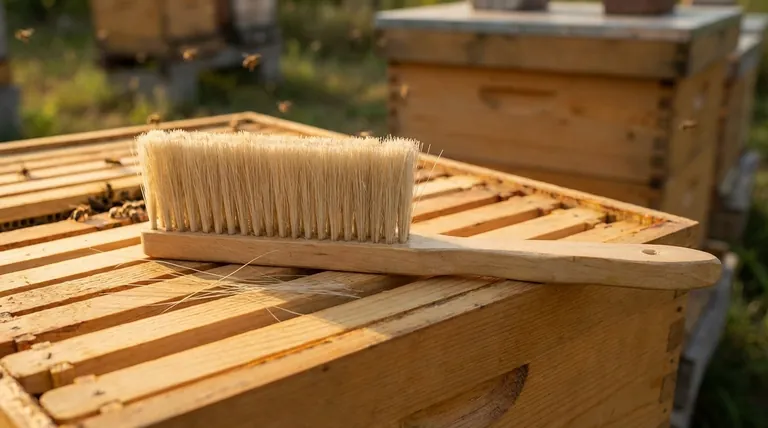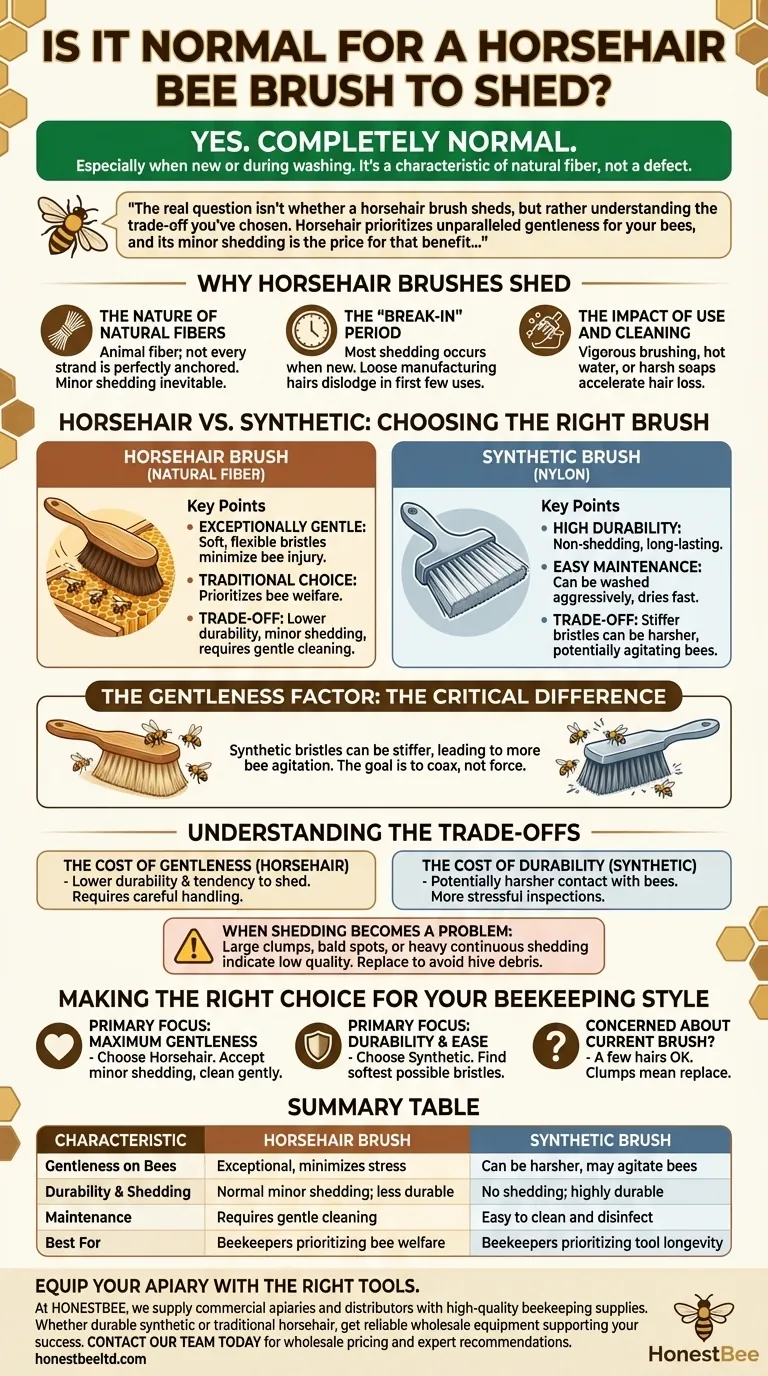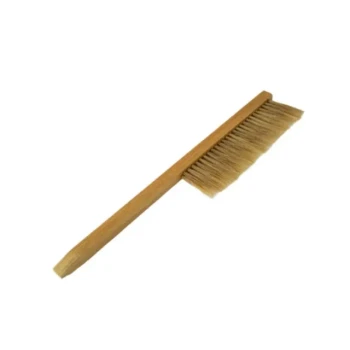Yes, it is completely normal for a horsehair bee brush to shed some of its hairs. This is especially common when the brush is new or during washing. As a natural fiber, some minor hair loss is an expected characteristic and not typically a sign of a defective product.
The real question isn't whether a horsehair brush sheds, but rather understanding the trade-off you've chosen. Horsehair prioritizes unparalleled gentleness for your bees, and its minor shedding is the price for that benefit when compared to more durable synthetic alternatives.

Why Horsehair Brushes Shed
The shedding you observe is rooted in the material itself and how the brush is constructed. Understanding this helps you distinguish normal behavior from a faulty tool.
The Nature of Natural Fibers
Horsehair is an animal fiber, and like all-natural hair, some amount of shedding is inevitable. The individual hairs are bundled and secured into the wooden handle, but not every single strand will be perfectly anchored for life.
The "Break-in" Period
Most shedding occurs when a brush is brand new. During manufacturing and shipping, some hairs can become loose. Your first few uses will dislodge these unseated hairs, after which the rate of shedding should decrease significantly.
The Impact of Use and Cleaning
Vigorous brushing or improper cleaning can accelerate hair loss. Exposing the brush to very hot water or harsh soaps can weaken the hairs or the adhesive holding them in place, leading to more shedding than is typical.
Horsehair vs. Synthetic: Choosing the Right Brush
Your choice of brush material has a direct impact on your bees and your workflow. Neither is universally "better," as they serve different priorities.
The Case for Horsehair
Horsehair is the traditional choice for one simple reason: it is exceptionally gentle. The long, soft, flexible bristles are ideal for moving bees without injuring their delicate wings or bodies, which helps keep the colony calm.
The Case for Synthetic (Nylon)
Synthetic brushes are valued for their durability and ease of maintenance. They do not shed, can be washed more aggressively, and dry faster, reducing the risk of spreading disease between hives if not cleaned properly.
The Gentleness Factor
This is the critical difference. While very durable, synthetic bristles are often stiffer than horsehair. This can lead to more bee agitation, damage, or defensive behavior if the beekeeper is not careful. The goal of a brush is to coax, not force.
Understanding the Trade-offs
Choosing a tool always involves balancing its strengths and weaknesses. The bee brush is no exception.
The Cost of Gentleness (Horsehair)
The primary trade-off for the soft touch of a horsehair brush is its lower durability and tendency to shed. It requires more careful handling and a gentle cleaning process to maximize its lifespan, which should still be several seasons.
The Cost of Durability (Synthetic)
The trade-off for a nearly indestructible, non-shedding synthetic brush is potentially harsher contact with your bees. This can make hive inspections more stressful for both the bees and the beekeeper.
When Shedding Becomes a Problem
Minor shedding is normal. However, if your brush loses hair in large clumps, leaves bald spots, or continues to shed heavily after a few uses, it likely indicates a low-quality product. Excessive loose hairs left in the hive can irritate the bees and become entangled in comb.
Making the Right Choice for Your Beekeeping Style
Proper care will extend the life of your tool, but choosing the right one from the start is key.
- If your primary focus is maximum gentleness on your bees: Choose a high-quality horsehair brush, accept the minor shedding as normal, and clean it by gently rinsing with cool water before air-drying.
- If your primary focus is durability and ease of cleaning: Opt for a synthetic brush, but make an effort to find one with the softest, most flexible bristles available to minimize bee irritation.
- If you are concerned about your current brush: A few lost hairs per inspection is acceptable, but if it sheds in clumps, it's best to replace it to avoid leaving debris in your hive.
Ultimately, the best bee brush is the one that allows you to work confidently and calmly, keeping your bees' welfare at the forefront.
Summary Table:
| Characteristic | Horsehair Brush | Synthetic Brush |
|---|---|---|
| Gentleness on Bees | Exceptional, minimizes stress | Can be harsher, may agitate bees |
| Durability & Shedding | Normal minor shedding; less durable | No shedding; highly durable |
| Maintenance | Requires gentle cleaning | Easy to clean and disinfect |
| Best For | Beekeepers prioritizing bee welfare | Beekeepers prioritizing tool longevity |
Equip your apiary with the right tools for gentle, efficient beekeeping.
At HONESTBEE, we supply commercial apiaries and distributors with high-quality beekeeping supplies designed for performance and bee health. Whether you need durable synthetic brushes or the traditional gentleness of horsehair, our wholesale-focused operations ensure you get reliable equipment that supports your success.
Let's discuss your apiary's needs. Contact our team today for wholesale pricing and expert recommendations.
Visual Guide

Related Products
- Wooden Bee Brush with Triple Row Artificial Fiber for Beekeeping
- Classic Wooden Bee Brush with Double-Row Boar Bristles
- Double Row Artificial Fiber Bee Brush for Beekeeping
- Plastic Handle Single Row Artificial Fiber Bee Brush
- Premium Triple-Row Horsehair Bee Brush
People Also Ask
- Why do beekeepers use a bee brush? The Essential Tool for Gentle Bee Handling
- What is a bee brush and how is it used in beekeeping? A Guide to Gentle Bee Handling
- What is a bee brush and what is its primary use? A Gentle Tool for Hive Management
- What are the characteristics of the bristles on a bee brush? Designed for Gentle Persuasion, Not Force
- What are the key features of a popular bee brush? Essential Design for Bee Safety and Hive Hygiene



















